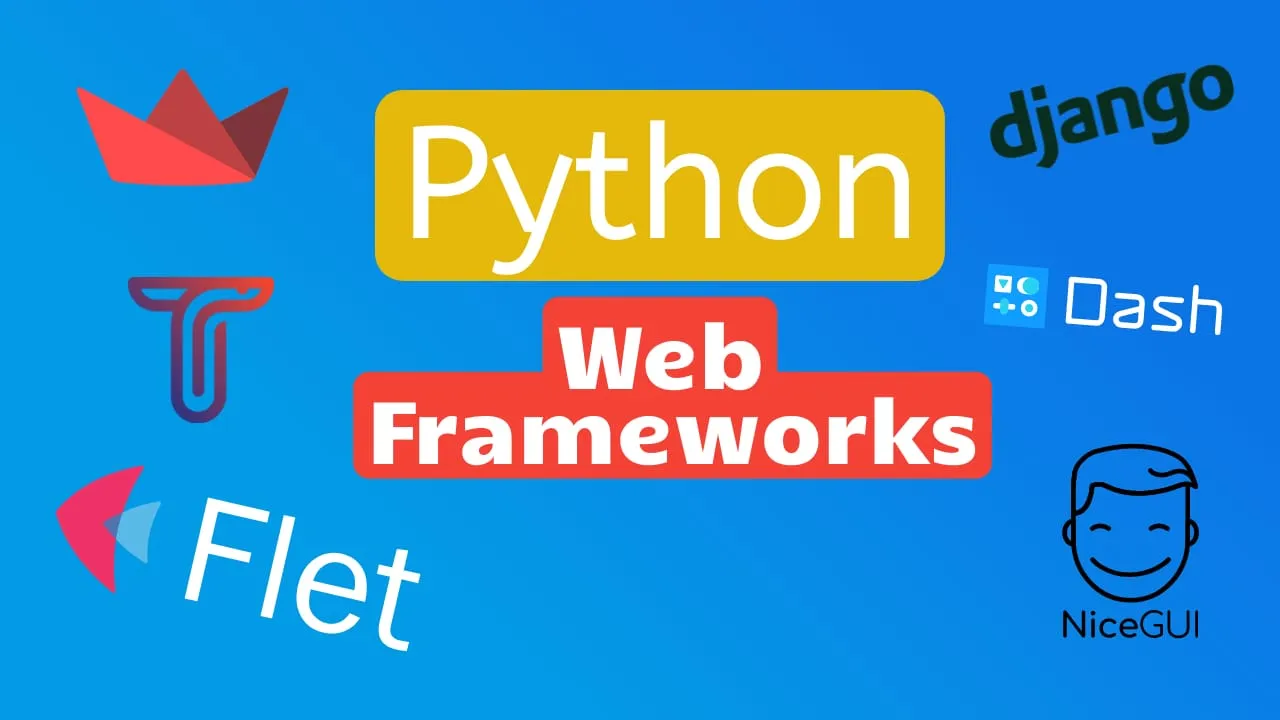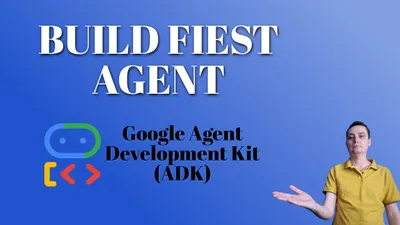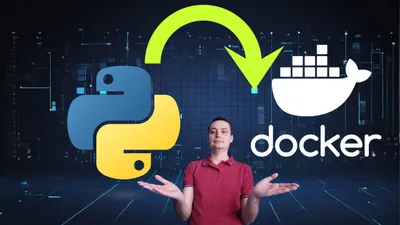30+ Best Python Web Frameworks for 2024
A complete list with the best Python Web Frameworks for 2024 that you can use to add an interface to your Python applications.

Python web frameworks are essential tools for developers looking to build web applications efficiently. These frameworks provide a structured and systematic approach to web development, offering pre-built components, best practices, and a way to automate many of the repetitive tasks involved in creating web applications. Python, being a popular programming language, has a wide range of frameworks catering to different needs, from simple applications to complex, high-traffic websites.
Types of Python Web Frameworks
Python web frameworks can be categorized into three main types:
-
Full-stack frameworks: These provide complete support for developing applications, including both frontend and backend components. They are designed to be an all-in-one solution, offering a wide range of functionalities out of the box.
-
Microframeworks: Lightweight and flexible, microframeworks offer the basics to get a web application up and running. They do not include additional functionalities like database abstraction or form validation, which allows developers to choose their tools and extensions.
-
Asynchronous frameworks: These are designed to handle a large number of concurrent connections, making them ideal for real-time applications. Asynchronous frameworks utilize Python’s asyncio library for managing asynchronous I/O operations.
-
Specialized Frameworks: These are designed for specific use cases such as RESTful API development, data analysis, or content management systems.
Advantages of Using Python Web Frameworks
Python web frameworks offer several benefits:
- Efficiency and Speed: By abstracting common patterns in web development, frameworks enable rapid development of applications.
- Security: Many frameworks include built-in security features that help protect against common vulnerabilities.
- Scalability: Frameworks often provide tools and features that support the growth of applications, handling increased traffic and data smoothly.
- Community and Support: Popular frameworks have large communities, offering extensive documentation, tutorials, and forums for troubleshooting.
Best Python Web Frameworks for 2024
Full-Stack Frameworks
Full-Stack Frameworks provide a one-stop solution for both front-end and back-end development needs. They include built-in libraries for form generation, template layouts, database interaction, and more.
-
Django: A high-level framework that promotes rapid development and clean, pragmatic design. It’s known for being secure and scalable, making it suitable for both small projects and large-scale applications Django Repo.
-
Pyramid: Known for starting simple and being able to scale up to complex applications. It allows developers to choose components for templating, databases, and security, providing flexibility and control Pyramid Repo.
-
TurboGears: A framework that can start as a single-file app and scale up to a full-stack solution. It’s built on top of several other frameworks and offers a mix of full-stack and microframework capabilities TurboGears Repo.
-
Web2py: A full-stack framework that requires no installation or configuration. It’s designed for rapid development of secure database-driven web applications Web2py Repo.
-
CubicWeb: An open-source framework built with Semantic Web principles. It emphasizes reusability through components and an explicit data model CubicWeb Repo.
-
Taipy: A framework that integrates with existing open-source libraries and provides a set of robust features and tools for web application development Taipy Repo. Read more on Taipy vs Streamlit
-
Masonite: A modern and developer-centric Python web framework that aims to be a tool for crafting powerful web applications quickly and easily Masonite Repo.
-
Zope & BlueBream: A framework that allows for the development of complex web applications with a strong emphasis on reusability and component-based development Zope Repo.
Microframeworks
Microframeworks are lightweight and suitable for applications that do not require a lot of additional functionalities like database abstraction layers or form validation. They are ideal for small to medium-sized applications.
-
Flask: A lightweight WSGI web application framework that is easy to get started with and can scale up to complex applications Flask Repo.
-
Bottle: A fast, simple, and lightweight WSGI micro web-framework for Python. It is distributed as a single file module and has no dependencies other than the Python Standard Library Bottle Repo.
-
CherryPy: A minimalist Python web framework, allowing developers to build web applications in much the same way they would build any other object-oriented Python program CherryPy Repo.
-
Dash: A productive Python framework for building web applications. Written on top of Flask, Plotly.js, and React.js, Dash is ideal for building data visualization apps with highly custom user interfaces in pure Python Dash Repo.
-
Falcon: A bare-metal Python web API framework for building very fast app backends and microservices Falcon Repo.
-
Hug: A framework that aims to make developing Python-driven APIs as simple as possible, but no simpler Hug Repo.
-
web.py: A web framework for Python that is as simple as it is powerful web.py Repo.
Asynchronous Frameworks
Asynchronous Frameworks are designed to handle a large number of concurrent connections and are built on Python’s asyncio library. They are perfect for applications that require real-time features and high concurrency.
-
Sanic: A web server and web framework that’s written to go fast. It allows the usage of the async/await syntax added in Python 3.5, which makes your code non-blocking and speedy Sanic Repo.
-
Tornado: A Python web framework and asynchronous networking library, originally developed at FriendFeed Tornado Repo.
-
AIOHTTP: An asynchronous HTTP client/server framework for asyncio and Python AIOHTTP Repo.
-
FastAPI: A modern, fast (high-performance), web framework for building APIs with Python 3.7+ based on standard Python type hints FastAPI Repo.
-
UvLoop: An ultra-fast, drop-in replacement for the asyncio event loop. UvLoop is implemented in Cython and uses libuv under the hood.
-
Starlette: A lightweight ASGI framework/toolkit, which is ideal for building high-performance asyncio services Starlette Repo.
-
Quart: A Python ASGI web microframework with the same API as Flask, allowing for Flask extensions to run Quart Repo.
Specialized Frameworks
Specialized Frameworks are designed for specific use cases such as RESTful API development, data analysis, or content management systems.
-
Streamlit: An open-source app framework for Machine Learning and Data Science teams. Create beautiful data apps in hours, not weeks. All in pure Python Streamlit Repo. Check Streamlit Deploy in VPS to see how you can run your Streamlit apps.
-
Anvil: A platform for building full-stack web apps with nothing but Python. It allows you to write your client-side code in Python and deploy it over the web Anvil Repo.
-
Plotly Dash: A productive Python framework for building web applications. Written on top of Flask, Plotly.js, and React.js, Dash is ideal for building data visualization apps with highly custom user interfaces in pure Python Dash Repo.
-
Panel: A high-level app and dashboarding solution for Python. Panel works with visualizations from Bokeh, Matplotlib, HoloViews, and many other Python plotting libraries Panel Repo.
-
NiceGui: A user interface framework that allows you to create beautiful and responsive web applications with Python only NiceGui Repo. You can check also Streamlit vs. NiceGUI for an in-depth comparison. You can check NiceGUI for Beginners to find out more.
-
Reflex: A library for building React applications with Python Reflex Repo .
-
Flet: A framework that enables building interactive multi-user web, mobile, and desktop apps in Python without prior experience in frontend development Flet Repo.
-
Justpy: An object-oriented, component-based, high-level Python web framework that requires no front-end programming Justpy Repo.
-
Lona: A web application framework, designed to write responsive web apps in full Python Lona Repo.
-
ReactPy: A package that allows you to create interactive web applications in Python using components ReactPy Repo.
-
Reahl: A web application framework that allows a Python programmer to work in familiar object-oriented paradigms and to use a single programming language to create all parts of a web application Reahl Repo.
This list includes some of the most popular and widely used Python web frameworks, each with its unique features and capabilities. Whether you’re building a simple web application, a high-performance API, or a full-fledged web service, there’s a Python web framework that fits your project’s needs.
Choosing the Right Framework
Choosing the right Python web framework for your web development project is a critical decision that can affect both the development process and the success of the application. Here are some key considerations to help you make an informed decision:
Project Size and Scope
- Full-stack frameworks are generally better for larger applications that require a comprehensive suite of features right from the start.
- Microframeworks are more suitable for smaller, simpler applications where you want the flexibility to pick and choose the components you use.
- Asynchronous frameworks are ideal for applications that need to handle many concurrent connections, such as chat apps or real-time data processing systems.
Learning Curve
- Evaluate the complexity of the framework and the time it will take for your team to become proficient in using it.
- Consider the availability of documentation, tutorials, and community support, which can help speed up the learning process.
Community and Support
- A strong community can be a valuable resource for finding solutions to problems, discussing best practices, and staying updated with the latest developments.
Performance and Scalability
- Consider how well the framework can handle the growth of your application, both in terms of user base and functionality.
- Some frameworks are optimized for performance and can handle high loads more efficiently.
Security
- Security is paramount, so it’s important to choose a framework with robust security features or one that makes it easy to implement security best practices.
Long-Term Viability
- Look for a framework that is actively maintained and has a roadmap for future development to ensure it will continue to meet your needs as your project evolves.
Specific Project Requirements
- Think about the specific features you need for your project. If you need a powerful ORM, an admin interface, or built-in security features, a full-stack framework might be the best choice.
- If you need a lightweight application with minimal dependencies, a microframework could be more appropriate.
Developer Preference and Project Philosophy
- The preferences of your development team and the overall philosophy of the project can also influence the choice of framework.
In summary, the right Python web framework for your project will depend on a variety of factors, including the size and complexity of the project, the team’s expertise, the speed of development, community support, performance and scalability considerations, security needs, and the long-term viability of the framework. It’s important to choose a framework that aligns with your project’s specific requirements and your team’s capabilities. Popular frameworks like Django, Flask, and FastAPI cater to different types of projects and offer their own sets of advantages.
Conclusion
Python’s web framework ecosystem is rich and varied, offering solutions for all kinds of web development needs. Whether you’re building a simple application or a complex system, there’s a Python web framework that can help you achieve your goals efficiently.
Related Posts

Getting Started with uv: Setting Up Your Python Project in 2025
See how you can get started with uv, a next-generation Python package and project manager written in Rust by the Astral team.

How to Build Your First Agent with Google Agent Development Kit (ADK)
Learn how you can start building your first agent with Google Agent Development Kit (ADK) and add memory and tool use to browse the web.

How To Run Any Python App in Docker with Docker Compose
Learn how Run Any Python App in Docker with Docker Compose and add an SSL certificate thru CloudFlare tunnels